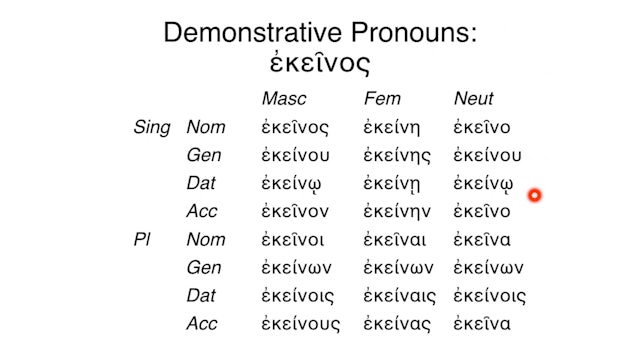Reading Biblical Greek (Constantine R. Campbell)
Based on Reading Biblical Greek written by Richard J. Gibson and Constantine R. Campbell, this series is designed around three core elements: grammar, vocabulary, and reading and translation. It introduces you to the essential information you need to optimize your grasp of the fundamentals of biblical Greek—no more and no less—and help you read and translate the Greek of the New Testament as soon as possible.
The learning approach in the Reading Biblical Greek course revolves around three core elements: grammar, vocabulary, and reading and translation.
• Grammar. The grammar consists of micro-lessons, which break up information in small, digestible chunks. Each micro-lesson addresses a single point. This arrangement makes for easy comprehension and review. New learning is incremental and recursive—each new piece builds on and reinforces prior learning.
• Vocabulary. As an essential complement to grammar, vocabulary is introduced at strategic points and is arranged first by what you have been learning in grammar, and then by frequency.
• Reading and Translation. The goal of this series is to enable students to read and translate the Greek of the New Testament. Thus, the content is structured and tied to a specific Greek text to enable reading as soon as possible. The student will have read and translated the whole of Mark 1–4 by the end of the series.
While Reading Biblical Greek only introduces you to information that is essential to grasp the fundamentals of the Greek language, it is informed by the latest and best of Greek and linguistic scholarship, enabling you to move seamlessly into further study.
By watching this series, you will gain:
• familiarity with the basic rules of New Testament Greek grammar
• a basic grasp of beginning-level Greek vocabulary
• experience in applying grammar and vocabulary lessons to actual translation
-
Reading Biblical Greek - Session 46 - Passive Voice
-
Reading Biblical Greek - Session 47 - Middle Voice
-
Reading Biblical Greek - Session 48 - Verbs with Middle Lexical Forms
-
Reading Biblical Greek - Session 49 - The Verb ἔρχομαι
-
Reading Biblical Greek - Session 50 - Future Tense-Form: Middle and Passive
-
Reading Biblical Greek - Session 51 - Aorist Passive
-
Reading Biblical Greek - Session 52 - Liquid Stem Verbs
-
Reading Biblical Greek - Session 53A - 2nd Aorist Tense-Form
-
Reading Biblical Greek - Session 53B - 2nd Aorist Tense-Form: Outside the Indicative
-
Reading Biblical Greek - Session 54A - Participles: Feminine and Neuter
-
Reading Biblical Greek - Session 54B - Participles: Feminine and Neuter continued
-
Reading Biblical Greek - Session 55 - Demonstrative Pronouns
-
Reading Biblical Greek - Session 56A - Adjective Positions and Special Uses of αὐτός
-
Reading Biblical Greek - Session 56B - Words That “Take” the Predicative Position
-
Reading Biblical Greek - Session 57 - Reflexive Pronoun
-
Reading Biblical Greek - Session 58 - Relative Pronoun
-
Reading Biblical Greek - Session 59 - Participles: Middle and Passive Voices
-
Reading Biblical Greek - Session 60A - Perfect Tense-Form: Indicative Mood
-
Reading Biblical Greek - Session 60B - Perfect Tense-Form: Indicative Mood continued
-
Reading Biblical Greek - Session 61 - Perfect Non-Indicative
-
Reading Biblical Greek - Session 62 - Verbs Like δύναμαι
-
Reading Biblical Greek - Session 63 - Pluperfect Tense-Form
-
Reading Biblical Greek - Session 64 - οὐ and μή in Negation
-
Reading Biblical Greek - Session 65 - Subjunctive Mood


























